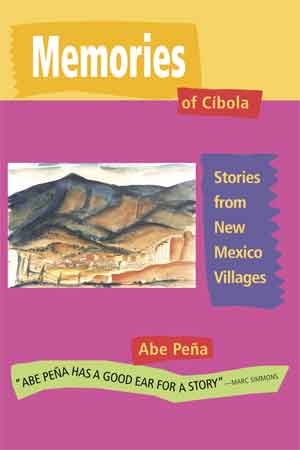from New Mexico Villages
by Abe Pena
240 pages, 30 photos/illustrations
$17.95 softcover (ISBN 1-890689-09-4)
$32.95 hardcover (ISBN 1-890689-29-2)




Winner, 2007 New Mexico Book Awards
FINALIST, 2007 BEST BOOKS USA BOOK NEWS
FIRST PLACE NONFICTION, HISTORY, 2007 NEW MEXICO PRESS WOMEN COMMUNICATIONS AWARD
FINALIST, BIOGRAPHY, 2007 INDIE EXCELLENCE BOOK AWARDS
Listed as 34th Most Popular Southwest Book on Amazon.com (10/4/08)

Let Abe Peña transport you to a Hispanic New Mexico village. There in San Mateo and in the nearby town of Grants, he introduces us to relatives and friends from his youth on his family’s sheep ranch. His stories of their lives and experiences between the 1920s and the 1950s speak to such universal themes as coming of age, striking out on one’s own, and joining family and neighbors to celebrate good times and to aid them in overcoming hardships. Though San Mateo was a remote village, its residents were a remarkable cross-section of humanity. We meet Lebanese immigrant children who grew up primarily speaking Spanish and who proudly exclaimed “Yo soy mexicano, casi” (I’m Hispanic, almost). When a religious procession done in hopes of bringing rain results instead in hail, the villagers organize a second procession and parade their patron saint to show him “the mess he made.” And an aged Navajo, in allowing cattle to be driven across his land, asks only that they go by his hogan’s door so he can hear and smell them. Abe Peña ran the family ranch for many years before serving twelve years in Latin America in various foreign service positions.
REVIEWS
This collection of stories ... provides valuable historical insights into rural Hispanic life, especially in northewrn New Mexico. Memories of Cibola introduces the struggles, ambitions, faiths, triumphs, and failures of the remarkable people of these places. Although written in a genuine and folksy style it is not always easy to read. Like many historical sourcebook collections, it has n o smotth narrative flow. Though Memories of Cibola seems like a bit if stew, with a little of this and a little of that, it is a dish well worth sampling. The reader will be more than compensated for the difficuklties in the book by the value of the insights to be gained between its covers. -- New Mexico Historical Review, Winter 2008
These stories of Hispanic life in Cibola County, west central New Mexico, are organized into 6 parts for each of the locales covered. Within each section, for example, part one, focusing on the village of Seboyeta, are stories of the people, places, and activities, essentially between 1920-1950, but some reaching back to colonial times. Many of the stories, some previously published in issues of the Cibola County Beacon (formerly the Grants Daily Beacon) newspaper, describe aspects of the sheep business, New Mexico's leading industry from colonial times until the mid-19th century but still a viable business in CГbola County until about the mid-1960s, especially in concert with cattle ranching.В In fact, the author points out that under proper management sheep and cattle "do better than either alone." And he certainly knows the sheep business as he studied wool production at the University of New South Wales, Australia, while a Fulbright scholar, returning to the United States where he became foreman on one of New Mexico's largest sheep operations.
Village life in San Mateo, San Rafael, Grants, Fort Wingate, the tradition of la matanza (a community-wide event of pig slaughtering for lard for the holidays, held in the late fall or early winter), the Lebanese settlers, various ranches, holidays and special events, people, and many other stories are related in detail in the book. Hardly a traditional enterprise but very significant economically to Cibola County, Ambrosio Lake, 25 miles north of Grants, produced more uranium from 1950 to 1980 than any other place in the world. A glossary, index and bibliography round out this interesting book of folk history. After managing the family ranch at San Mateo the author was director of the Peace Corps in Honduras, then directed Peace Corps and USAID programs in several other Latin American countries. -- New Mexico Magazine
Longtime Prime Time readers will remember Abe Pena's easy, warm, down-to-earth narratives of the world in which he grew, learned, married, ranched and observed his neighbors. Many have read Memories of Cibola, his first, respected book. Now Rio Grande Books in Los Ranchos has reprinted that volume and Abe's latest work, Villages & Villagers. I have read only Marc Simmon's foreword, in which--after describing Abe as storyteller, folklorist and historian-- he writes that Abe "shines as a keen observer of the human condition." Don't wait for me-- pick up one or both.--Arthur Alpert, Prime Time, March 2007.
ABOUT THE AUTHOR:
Abe Peña writes about the people of San Mateo and other nearby places from the 1920s to 1950s. Pena, who lives in Grants, grew up on a sheep ranch near San Mateo, immersed in the traditional Hispanic culture of west-central New Mexico. He ran the family ranch for many years before serving 12 years in Latin America in foreign service positions. Pena writes about traditional events such as Los Pastores, the shepherds’ pageant performed at Christmas time. He remembers Spanish-speaking Lebanese immigrant children who proudly proclaimed, “Yo soy Mexicano, casi” (I’m Hispanic, almost). He tells of villagers who in a drought paraded a statue of their patron saint in hopes of rain. When hail fell instead, they took him out of the church again to show him “the mess he made.”
“Peña has a good ear for a story,” says historian Marc Simmons, who wrote the book’s introduction. “The engaging men and women who walk so freely through his pages seemed infused with the elixir of southwestern air and landscape and with the tonic of their own vibrant cultural history.”
WHAT PEOPLE ARE SAYING ABOUT MEMORIES OF CÍBOLA
“ Abe Peña has a good ear for a story.’ — Marc Simmons
“One can do no better than Abe Peña’s 65 vignettes of life in the village of San Mateo and in the nearby town of Grants.”—Alibi
“A master storyteller, Peña captures the mood and the spirit of yester-year as he weaves his tales about the daily lives of Cíboleros. A variety of captivating photographs, some dating back to the turn of the century, and reproductions of correspondence are an added bonus.”— New Mexico Magazine
“This is a entertaining book... about people who survived in a wilderness.”—La Herencia

